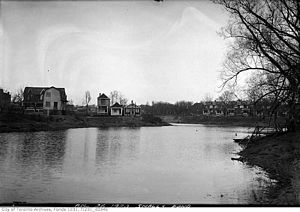Small's Pond (Ontario): Difference between revisions
George Swan (talk | contribs) ({{subpages}}) |
Pat Palmer (talk | contribs) m (Pat Palmer moved page Small's Pond to Small's Pond (Ontario) without leaving a redirect) |
||
| (One intermediate revision by the same user not shown) | |||
| Line 1: | Line 1: | ||
{{subpages}} | {{subpages}} | ||
[[File:Houses overlooking-Smalls-Pond -a.jpg|thumb|Houses overlooking Smalls Pond.]] | [[File:Houses overlooking-Smalls-Pond -a.jpg|thumb|Houses overlooking Smalls Pond.]] | ||
''' | '''Small's Pond''' was a pond located near [[Queen Street, Toronto|Queen Street East]] and [[Kingston Road (Toronto)|Kingston Road]] in Toronto, Canada. <ref name=BlogTO2012-04-21/><ref name=Spacing2015-10-15/><ref name=VanishingPoint/> Some accounts say it was twelve feet deep, others that it was twelve meters deep. While some accounts say it was a natural feature, Jane Fairburn, in ''"Along the Shore: Rediscovering Toronto's Waterfront Heritage"'', wrote that gentleman farmer [[Charles Coxwell Small]], owner of 472 acres, dammed a creek than called [[Serpentine Creek]], to form the dam, for the water-power for sawmills.<ref name=AlongTheShore/> | ||
In late 19th century winters its ice was harvested and stored, in slabs, as its waters remained clean, when the nearby [[Don River, Ontario|Don River]] had become polluted.<ref name=BlogTO2012-04-21/> Stored slabs of ice were used to keep food cool before artificial refrigeration had been invented. | In late 19th century winters its ice was harvested and stored, in slabs, as its waters remained clean, when the nearby [[Don River, Ontario|Don River]] had become polluted.<ref name=BlogTO2012-04-21/> Stored slabs of ice were used to keep food cool before artificial refrigeration had been invented. | ||
Latest revision as of 12:24, 31 January 2024
Small's Pond was a pond located near Queen Street East and Kingston Road in Toronto, Canada. [1][2][3] Some accounts say it was twelve feet deep, others that it was twelve meters deep. While some accounts say it was a natural feature, Jane Fairburn, in "Along the Shore: Rediscovering Toronto's Waterfront Heritage", wrote that gentleman farmer Charles Coxwell Small, owner of 472 acres, dammed a creek than called Serpentine Creek, to form the dam, for the water-power for sawmills.[4]
In late 19th century winters its ice was harvested and stored, in slabs, as its waters remained clean, when the nearby Don River had become polluted.[1] Stored slabs of ice were used to keep food cool before artificial refrigeration had been invented.
The farmland surrounding the lake, and the small creeks that fed it, were annexed into the growing city of Toronto around the turn of the 20th Century.[1] By 1909 those creeks had become polluted, and were buried and converted into sewers.
In 1919, a 9-year-old boy drowned in the pond.[1]
In 1935, after the creeks that fed it had been diverted, the pond had become stagnant, and was drained and filled in.[1]
References
- ↑ 1.0 1.1 1.2 1.3 1.4 Chris Bateman. A brief history of Small's Pond, used then abused, Blog TO, 2012-04-21.
- ↑ 5 subtle signs of Toronto's lost rivers. Spacings Toronto (2015-10-15). Retrieved on 2016-08-01.
- ↑ Michael Cook. Beneath Toronto's East End: The East Toronto and Midway Sewer System. Vanishing Point. Retrieved on 2016-08-01. “Up until 1908, Toronto's city limit ended just east of Greenwood Ave., on the western shoulder of the Ashbridges Creek ravine, save for a narrow strip the city had already claimed along the lakeshore as far as Balmy Beach.”
- ↑ M. Jane Fairburn (2013). Along the Shore: Rediscovering Toronto's Waterfront Heritage. ECW Press. ISBN 9781770410992.
